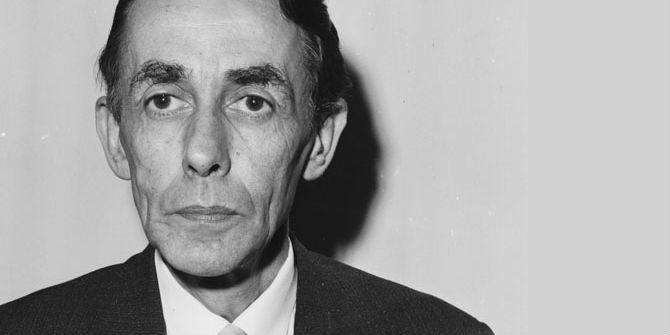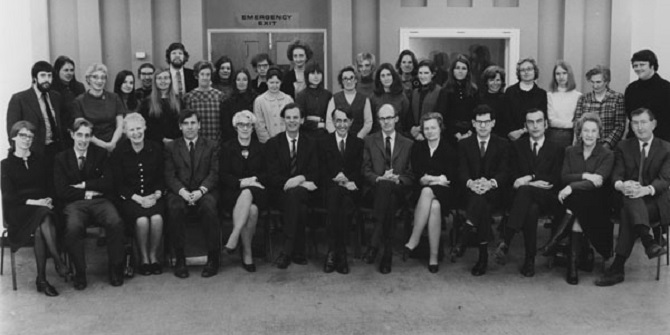As the NHS reaches its 70th anniversary, LSE Library’s Inderbir Bhullar explores the involvement of LSE’s Richard Titmuss and Brian Abel-Smith in the 1953 Guillebaud Report on the costs of the NHS.
On 5 July 2018 the NHS celebrates its 70th birthday. The anniversary will likely focus on how it came to be born as part of William Beveridge‘s revolutionary plans for reformed social services, conceived during the Second World War and given legislative birth by Clement Attlee‘s post-War Labour government. Celebrations, however, will likely also be tempered by reports of the ongoing funding crisis that has dominated headlines about the NHS.
Controversies over the NHS’ budgets aren’t a recent issue. LSE Library holds in its archives the papers of Richard Titmuss and Brian Abel-Smith, two social policy academics who were involved in a very early review of NHS spending as part of the Guillebaud Committee.

A committee on the cost of the NHS
The official name given was the “Committee of Enquiry into the Cost of the National Health Service” and a Cambridge economist named Claude William Guillebaud was charged with its operation.
The Committee was established in 1953 by a Conservative government which, in its victorious 1951 election manifesto, had declared: “in order to lower taxes and the high cost of living we must cut down Government spending”. While this stopped short of drastically scaling back an already popular NHS, the Conservative party had made promises of savings and efficiencies that led to the establishment of the Committee.

Charges for access to certain NHS services had already been accepted as a principle by the 1950 Labour government, to stem the unanticipated costs of the new service, which has been ascribed as one of the reasons that Aneurin Bevan – architect of and fierce advocate for the NHS – resigned from his cabinet post. The Conservatives, in 1952, were the first to make the charges concrete. The Guillebaud Committee, established just a year later, was another effort to analyse the costs of what was seen as a popular yet costly service.
The Guillebaud Report
The findings published in 1956, in something of a twist to the prevailing narrative, showed that rather than being too expensive, the NHS had been underfunded as its share of the overall GDP had fallen from 3.75% to 3.25% during the period of review (1948-54). The work also found that a general rise in costs and prices because of inflation had been behind the apparent costliness and contributed to the appearance of a profligate service. The findings were effective and in the immediate aftermath of their publication convinced the government to hold back on cuts to the health service. The usage of health spending as a proportion of GDP remains a standard way of presenting the costs of health services and can be useful for comparison with other countries.

Abel-Smith and Titmuss went on to publish a book in 1956 which contained further analysis and a detailed summary of the study which was called The cost of the National Health Service in England and Wales. Some of the evidence and findings upon which both men based their analysis can be found in their archives. This includes, for example, this list of food and drink expenditure from a hospital in Paddington which also featured in the Library’s recent exhibition all about the welfare state.

Abel-Smith and Titmuss at LSE
Richard Titmuss had already been appointed to the Chair of Social Administration at LSE by the time the Committee had been appointed. He had not had a traditional route into academia having left formal education at 14 and worked in insurance for many years. He developed both interest and insight into issues impacting public health, population and broader social policy which led to the writing and publication of numerous books and articles.

Such interests made him an ideal collaborator with Brian Abel-Smith who shared Titmuss’ desire to see strong, universal public services operating effectively. Abel-Smith was a researcher with the National Institute of Economic and Social Research when he was seconded to start work on gathering evidence for the Guillebaud Committee but in 1955 was invited to join the School by his collaborator Titmuss as an Assistant Lecturer. For both, the School then became their home for many years afterwards as they continued to research, develop and share their expertise on a variety of social issues, and used this knowledge to impact policy.

As the anniversary of the NHS gets nearer, the ongoing diagnosis of its funding issues and financial ill-health attracts a litany of voices offering opinion and cure. Though two of its most vehement allies are no longer able to provide their perspective, their research points to how rational argument and analysis could help resist cutbacks.
Visit the LSE Richard Titmuss biography




It is difficult topic. Especially public funding on whatever it is used makes it difficult. NHS is another story…